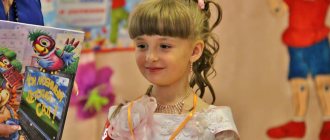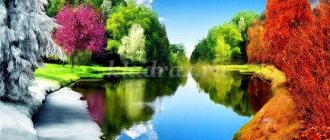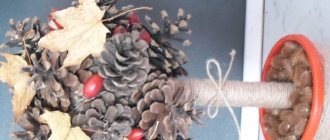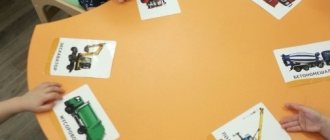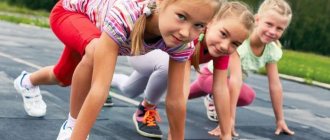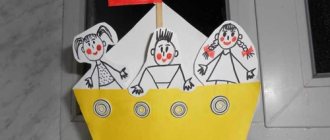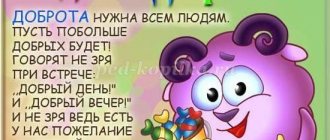Summary of an integrated lesson in the preparatory group.
Municipal autonomous preschool educational institution, general developmental kindergarten No. 38, Tomsk
Summary of an integrated lesson in the preparatory group
"Journey to the Land of First-Graders"
Educator:
Andreeva Svetlana Georgievna
Tomsk - 2022
Summary of an integrated lesson in the preparatory group
"Journey to the Land of First-Graders"
Target. Creating conditions for activity and independence in positive activities. Objectives: Identify the level of knowledge in the cognitive and speech areas. Create a desire to learn. Develop curiosity and the ability to work in a team. Develop a responsible attitude towards nature. Material and equipment. Map of the country of First-graders. Geometric shapes cut in half. Squares consisting of four cells. Cards with examples, numbers, capital letters of children's names, words, sentences. Subject pictures. Encrypted picture. Painting "Views of the forest". Letters from the split alphabet (Ш, К, О, Л, А). Plastic bags. Balloons. Ball. Colored paper. Scissors. Medals “Future first-grader” (“Future first-grader”). Progress of the lesson. — Guys, tell me what countries do you know? What is the name of our country? Do you think kindergarten can be called a country? (Yes). And why? (There are both adults and children here. We live here. Like any country, the kindergarten lives according to a certain regime. We have our own laws and rules. There are borders. There is a person who runs the kindergarten.) Let's give this country a name. (Country of childhood, country of preschool children). Soon you will leave the land of preschoolers and go to school, where you will first meet the Land of first graders. Today I suggest you visit this country for a short time to make sure you are well prepared for school. Here is a map of the country of first-graders. Let's look at it. (Children look at the map). In our country of Preschoolers there are four wonderful cities: the city of Soschitaika, the city of Poznavaika, the city of Pochitaika, the city of Experimental. In each city, tasks await you. Which city do you want to go to? (Children choose a city) Before us is the city of Soschitayka. This city has prepared the following tasks for you: you must first count from 1 to 20, then in reverse order. Game "Pass the ball". While counting, children pass the ball to each other in a circle. Game “Find a Pair” Educator. There are halves of geometric shapes on the table. You must find a pair, make a shape and name it. (Children complete the task). The next task is “Fun Squares”. Write numbers into the cells of the square so that the sum of the numbers in each vertical, horizontal and diagonal is equal to 9. “Compare the numbers” Children are given cards in which they must put signs. Warm up. The teacher one by one shows the children cards with numbers and gives tasks. Children perform each movement several times - in accordance with the number shown. Educator. (Card with the number 7.) Let's clap our palms so many times. (Card with number 3.) Let’s stamp our foot so many times. (Card with number 4) We will jump so many times. (Card with number 2.) We will bend over now. Oh yes, counting is a game, and that’s all! It's time for a joke. Solve unusual problems. -How many chickens did the rooster hatch if he laid five eggs? — What do crocodiles eat at the North Pole? — Four eggs are boiled for four minutes. How many minutes does it take to cook one egg? — There are five boys in the group. Each boy invited one girl to dance. How many children were dancing? — Seven geese set off on their journey, Two decided to rest. How many are there under the clouds? Count it yourself, children. - The apples in the garden are ripe, We managed to taste them: Three sweet ones, two with sourness. How many are there? Well done! You completed the tasks. What's the next city you want to go to? Before us is the city of Poznavaika. Residents of the city of Poznavayka have prepared questions for you, answer them - What planet do we live on? — What can be called a model of our planet? — Which city is the capital of our state? - What city do we live in? Educator. An encrypted picture awaits us in the city of Poznavayka. Name the sounds with which words begin - the names of the objects depicted, and you will find out which word is encrypted in the picture. Vase, spruce, table, sock, watermelon. (Spring) Remember the proverbs and sayings about spring. Spring rain grows, and autumn rain rots. Spring is red with flowers, and autumn is red with pies. March is with water, April is with grass, and May is with flowers. Spring has come, so there’s no time for sleep. Educator. At the end of April - beginning of May, young leaves appear on trees and bushes. What trees and shrubs do you know? Ball game “Trees and Shrubs” Children stand in a circle. The teacher throws the ball to the children one by one. They name trees and bushes and return the ball to the teacher. Educator. Most of these trees grow in the forest. What types of forests do you know? (deciduous, coniferous, mixed). Show these forests in the picture. Educator. Make riddles about the animals that live in the forest. (Children make a wish). Commercial break. Educator. Guess which fairy-tale characters could give the following advertisements. “I lay golden eggs. Expensive!" (Pockmarked chicken) “I’ll wash everything!” (Moidodyr.) “I’ll take the pies to your grandmother” (Little Red Riding Hood) “I treat animals with travel to any part of the world” (Aibolit) Well done! Educator. And now in front of us is the city of Pochitayka. Let's see what tasks await you in this city? For each completed task you will receive a letter and be able to form a word. Are you ready to work hard? (Yes). "Take your seat." The capital letters of your names are laid out on the tables. Find your letter. "Decipher the word." I encrypted the word, you must recognize it by letter! Listen carefully! The first letter in the encrypted word stands for the hissing consonant in the word “noise.” The second letter denotes a consonant sound, which is found in both the word “branch” and the word “bark”. The third letter is the stressed vowel sound in the word “field”. The fourth letter is the third sound in the word “wolf”. The fifth letter is a vowel sound that is repeated in the word “grass.” What word did you get? (School) How many sounds are in this word? How many consonants are there? How many vowel sounds? What is the drum sound? How many syllables are in a word? "The word has crumbled." Educator. There are syllable cards on the tables. It is necessary to form words from the available syllables. (Sna, ve - spring; ka, floor - shelf; na, shi, ma - machine; pel, ka-kapel; ta, kar - card; ta, par-parta; ka, ruch - pen; cash, pe - pencil case .) Children complete the task. “Make a proposal.” The teacher distributes cards with words. Children make sentences from them. Educator. Well done! You have arrived in the city of Pochitayka. And now we are going to the city of Experimental. Educator. I suggest you do some research. What will we explore? Guess the riddle. It passes through the nose into the chest and goes the other way. It is invisible, but still we cannot live without it. We need it to breathe, to inflate the balloon. He is with us every hour, but he is invisible to us! (Air). Yes, it's air. What is air needed for? (to breathe) - Yes, we are so used to it that we don’t even notice. Well, let's first take a deep breath and then exhale. - What did you and I inhale? (air). We don't see him. So what is he like? (transparent, invisible, colorless). To feel the air, you need to catch it! Do you want me to teach you how to catch air? (Yes). Take a plastic bag. Is there something in it? (no, it is empty, transparent). Let's catch the air with a bag. I show you how this can be done. Children repeat the movements. Educator. The bag is full of air, hold it tightly! Now open the package. (children complete the task). The air came out of the bag, and it again became empty and flat. Is there air inside our body? (children's assumptions). Now we will find out (takes balloons out of the box and distributes them to the children). Inflate the balloons (children complete the task). When you inflated the balloons, you filled them (with air). This means that there is air inside our body. - What would happen if the air disappeared on earth? (there would be no life on earth). An audio recording of melodic music is played. Children "fly" in balloons. Educator. So we returned to kindergarten. So that you remember our journey, I propose to lay out a stellar path of knowledge that will connect the Country of preschoolers with the Country of first-graders. On a common table, children fold stars using the origami technique. At the end of the work, the teacher and the children lay out the stars on the wallpaper. Then the teacher gives the children medals “Future First-Grader” (“Future First-Grader”). Reflection. Guys, did you enjoy our trip? In which city did you enjoy completing tasks the most? What tasks gave you difficulty? I really liked the way you completed the tasks today! You were persistent, attentive, quick-witted and therefore you managed to complete all the tasks, well done!
